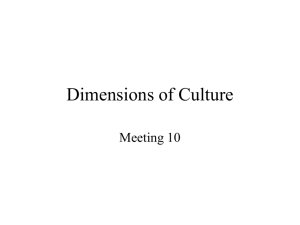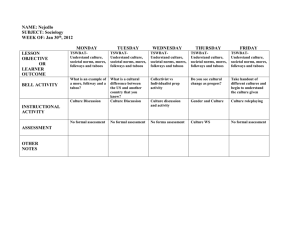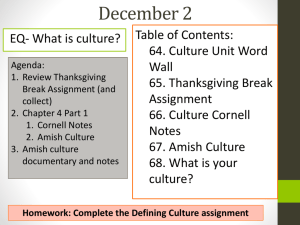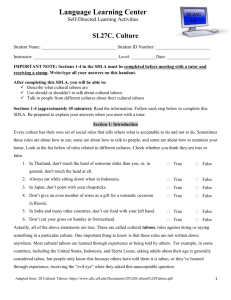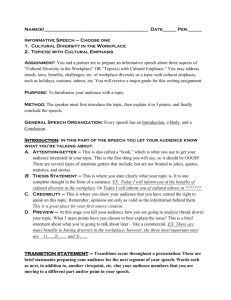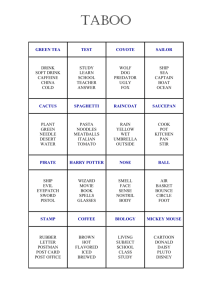Chapter 2: Taboo (with questions) - Southeastern Louisiana University
advertisement
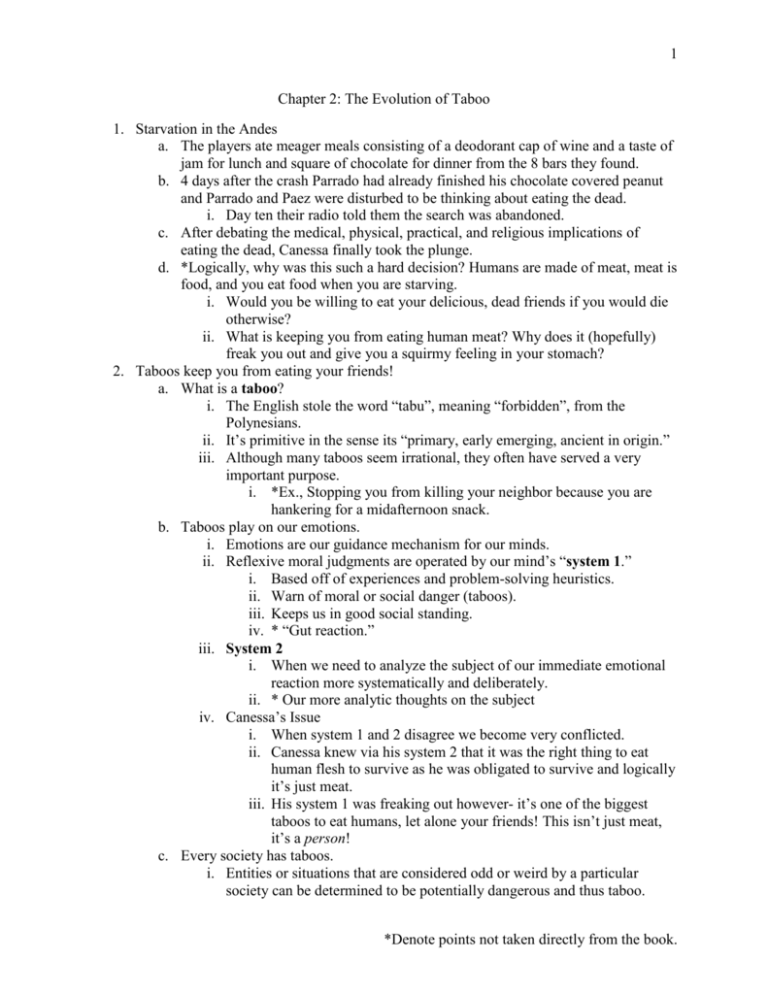
1 Chapter 2: The Evolution of Taboo 1. Starvation in the Andes a. The players ate meager meals consisting of a deodorant cap of wine and a taste of jam for lunch and square of chocolate for dinner from the 8 bars they found. b. 4 days after the crash Parrado had already finished his chocolate covered peanut and Parrado and Paez were disturbed to be thinking about eating the dead. i. Day ten their radio told them the search was abandoned. c. After debating the medical, physical, practical, and religious implications of eating the dead, Canessa finally took the plunge. d. *Logically, why was this such a hard decision? Humans are made of meat, meat is food, and you eat food when you are starving. i. Would you be willing to eat your delicious, dead friends if you would die otherwise? ii. What is keeping you from eating human meat? Why does it (hopefully) freak you out and give you a squirmy feeling in your stomach? 2. Taboos keep you from eating your friends! a. What is a taboo? i. The English stole the word “tabu”, meaning “forbidden”, from the Polynesians. ii. It’s primitive in the sense its “primary, early emerging, ancient in origin.” iii. Although many taboos seem irrational, they often have served a very important purpose. i. *Ex., Stopping you from killing your neighbor because you are hankering for a midafternoon snack. b. Taboos play on our emotions. i. Emotions are our guidance mechanism for our minds. ii. Reflexive moral judgments are operated by our mind’s “system 1.” i. Based off of experiences and problem-solving heuristics. ii. Warn of moral or social danger (taboos). iii. Keeps us in good social standing. iv. * “Gut reaction.” iii. System 2 i. When we need to analyze the subject of our immediate emotional reaction more systematically and deliberately. ii. * Our more analytic thoughts on the subject iv. Canessa’s Issue i. When system 1 and 2 disagree we become very conflicted. ii. Canessa knew via his system 2 that it was the right thing to eat human flesh to survive as he was obligated to survive and logically it’s just meat. iii. His system 1 was freaking out however- it’s one of the biggest taboos to eat humans, let alone your friends! This isn’t just meat, it’s a person! c. Every society has taboos. i. Entities or situations that are considered odd or weird by a particular society can be determined to be potentially dangerous and thus taboo. *Denote points not taken directly from the book. 2 ii. To outsiders, taboos and their prohibitions often seem superstitious, odd, and irrational. i. Ex., Catholics can’t eat meat on Fridays during Lent. ii. Ex., Polynesians who touch the dead aren’t allowed to do things such as eat with their hands or they chance dying. iii. Think you are different? Would you wear Hitler’s fur coat? i. Research says no. Why? ii. 80% of college students believed that wearing one of Mr. Roger’s sweaters transmits some of his humane essence to the wearer. a. Do you want Hitler essence in you? That’s just gross. iii. This weird thinking is due to magical contagion. a. The notion that by their association with someone/something, objects can possess and transmit some “essence” of that person or thing. b. It’s considered natural, adaptive, and pervasive in human cognition. c. Also attracts us to holy and religious symbols or items. d. Think you are better than this? Do you find poop shaped chocolate appealing? Probably not. 3. Taboos are often helpful and adaptive. a. Practical applications of taboos. i. * What if that poop chocolate actually wasn’t chocolate? Your aversion to eating this chocolate is due to the taboo of interacting with human waste. Human waste can be dangerous, especially if ingested, so this taboo is adaptive. ii. Our ancestors didn’t know of germ theory but they knew invisible transmission could get them sick, like from a dead body. Thus, touching dead bodies became taboo. b. Sacredness is more powerful, however, and universal for human societies. i. The idea that some objects, rules, ideas, traditions, and the like are backed by a transcendent authority. ii. Compliance with practical restrictions is always elevated if a powerful authority is believed to be behind them. i. Ex., you are more likely to obtain compliance with employee hand washing when the boss threatens to fire them if caught. iii. To disobey sacredness incurs the wrath of the divine authority. i. Violating taboos backed by sacredness no longer just endangers the individual but disregards society’s order. 4. Taboos make society. a. The historical universality of taboos indicates they have an important social function. b. Values hold us together. i. Acting in ways that specify interests. ii. Personal value i. Ex., I’m obsessed with football! iii. Societal value 3 i. Ex., My next girlfriend better love football too or our relationship will suck. ii. Societal values are personal values shared by more than one person. iii. In groups, these societal values can be signaled by their taboos. a. * Ex., Liking tennis instead of football in my house means you are stupid and we can’t be friends anymore! >:( c. Adherence to societal values and taboos signal commitment to society. i. Ex., Orthodox Jews and adherence to the Torah. i. The Torah is a shared value that binds together the Jewish community and they follow it strictly to advertise how committed they are to the community. ii. Ex., The Andaman Islanders i. Names hold special powers in their society and encapsulate the person’s entire being. ii. Those in transitional states such as the pregnant, recently dead, the recently married, those in mourning, and youths going through initiation are vulnerable. a. Using these people’s names could endanger them. iii. By observing this taboo and not using these individual’s names, they signal that one person’s vulnerability is a shared concern, or societal value, for the entire community. a. This respect of the taboo shows their commitment to their society. iii. Taboos symbolize shared values of the society. i. They allow members to express these values. ii. They define and unite communities. Those who do not share these societal values aren’t part of the community and are thus strangers. iv. Taboos symbolize what the community finds threatening and how to avoid this danger. i. Taboos encourage avoidance, rather than confrontation, which gave an advantage in our evolutionary past. ii. Ex., societal transitions are precarious situations and upheaval during this time period will destroy the community. a. The entire community’s fate is at stake during transitions and so taboos tell us how to deal with these scary times. b. The names and the Andaman Islanders are a good example. c. The taboos give a set of procedures in order to deal with this transition. d. These public displays of transition build trust in the community among members. 5. Breaking of Taboos. a. In society, breaking a taboo is equivalent to betrayal. b. Why were Parrado and Paez so upset to even think about eating their friends? i. These thoughts were dangerous- they preceded the breaking of a taboo. 4 ii. If one breaks one taboo where will it end? Even thinking about breaking a taboo makes society one step closer to breaking apart and it turning into a free-for-all. iii. This spiraling thought process is actually adaptive. i. Taboos represent sacred societal values of a group and even entertaining the thought of breaking them makes you suspicious. c. Taboo mentality i. The suspicion we feel towards those whom may break taboos. ii. Hospital Administrator study i. Scenario 1. The admin has to make a hard choice- due to limited resources he can only save one of two boys. a. He was viewed more positively if he took a long time to make the decision, regardless of which boy he chose. ii. Scenario 2. The admin has to make a taboo trade off this time- save the hospital a million dollars (secular) or save a boy’s life (sacred)? a. People regarded it as taboo to even contemplate this choice. b. The admin was viewed negatively if he took a long time to decide even if he decided to save the boy. c. The lack of an immediate revulsion to putting a sacred human life on the same level as money was enough to make him a negative character. i. A quick decision to save the boy made him be viewed more positively. iii. This study showed that it is less the actual decision one comes upon that cements trust in communities, but rather if the person has the right emotional guidance system that steers them clear of violating taboos. iii. Being considered untrustworthy is dangerous and thus we are motivated to adhere to taboos. iv. If we do violate a taboo then we must seek atonement in order to win back trust. i. We have to convince others that our bad behavior was a one-time thing and not indicative of our disposition. ii. One study found that those who perceived they broke a taboo, even inadvertently, displayed absolution seeking behavior. a. Found in those whom witnessed the taboo being broken but failed to condemn the behavior. b. Found that even being party to a taboo being broken is enough to trigger an aversive emotional reaction. c. These aversive feelings, such as guilt, serve as an emotional guidance mechanism. d. These feelings motivate us to engage in corrective actions to repair our self-image and our public reputation. 6. Evolutionary origins of taboo. a. Nothing in the nonhuman animal world is a true taboo as they don’t have sacredness. 5 b. Sex and reproduction were probably the first things that taboos evolved around as they have the most direct relevance to species fitness. i. Incest taboos are present in nearly all cultures and our primate relatives have inbreeding avoidance mechanisms. i. However, this does not necessarily reflect commitment to the group values as breeding with the “wrong” partner can have direct negative effects for individual fitness. c. Birth was most likely where taboos started. i. Humans have the most dangerous birthing process of all. i. Thus it has the highest evolutionary stake for taboos to grow from. ii. Birth taboos are nearly universal in traditional societies. ii. Australopethicus afarensis i. Arose about 4 million YBP, about 2-3 million years after the origin of the hominin evolutionary branch. ii. Were bipedal and had a human-like gait and bone structure. iii. Bipedalism constrained their pelvic dimensions. a. This makes a harder birthing process. b. Around the same time, newborn head and body size significantly increased. i. Chimps give birth to infants around 3% of their body mass and humans 6% of their body mass. ii. Ardipithecus ramidus (an earlier species) was apelike (3% of their body mass). iii. A. afarensis was more humanlike at 5%. 1. Infants were close to the pelvic opening size. 2. Suggests birthing complications happened early in hominin evolutionary history. iv. Newborn’s head must rotate away from the mother as it passes through the birth canal in humans. a. This makes it harder for the mother to guide the baby out and increases the need for assistance. b. A. afarensis probably didn’t have this problem. c. The earliest ancestor that did was most likely in a later species (600,000 YBP) called Homo heidelbergensis. v. Our ancestors needed a way to deal with all these problems effectively and thus created taboos. 7. Traditional birth. a. Traditional societies may be similar to what prehistoric life was like for humans. b. Pregnancy, birth, and food taboos are pervasive. i. Ex., Orang Asli tribes in west Malaysia. i. Pregnant women must only eat small animals as they have weak spirits and after giving birth she has to eat only gruel for a week. ii. Ex., Trobriand Islanders of Kiriwina i. Pregnant women may not eat fish that attach themselves to coral or fruits such as bananas or mangoes. a. Believe they cause difficult birth or birth defects. 6 iii. Ex., Lohorung Rai i. Pregnant women or new mothers must eat certain “hot” foods or drinks only. a. Chicken, meat, honey, rice, chicken broth, or warmed millet beer ii. Too many “cold” foods are thought to make the baby retreat back into the womb. iii. Hot and cold refers to symbolic power, not temperature. a. Health depends on maintaining a balance. c. The birth process itself has taboos in order to ensure a successful birth. i. Ex., The XKo (“bushmen” of Botswana) i. Before birth a woman’s body (except genitals) must be washed by attendants. ii. One attendant must wash her hand in special root juices and catch the baby. iii. The umbilical cord must be cut with their special instrument and never a knife. iv. The cord must be buried deep enough predators cannot get it. a. If they do that means the baby will die. b. It’s marked with thorns and branches. ii. Ex., !Kung San of southern Africa i. Women are to give birth alone in the bushes. ii. Women are only allowed to clench teeth or bite hand as crying or shouting due to pain means the woman does not really want the baby. iii. After the baby is born the mother must saw the cord off with sticks and wipe the cord clean with grass. iv. The bloody grass and placenta are covered with stones and branches to mark it. a. Burying the placenta can make the woman barren. v. Men aren’t allowed to step on or over the spot. a. The spot is tainted with a power that will cause a man to lose his masculinity and hunting ability. 8. Taboos require being linked to the supernatural. a. The supernatural aspect is still present in modern traditional societies. i. E.g., The XKo and the placenta power that takes away masculinity. b. The argument about the origins of the supernatural aspect of taboos is based on: i. (1 ) The origin of supernatural thinking lies (at least in part) in childhood imagination ii. (2) “neoteny” has played an important role in human evolution iii. (3) incorporating aspects of childlike thinking in adult cognition can be socially advantageous iv. (4) The adult social world had become increasingly complex c. Childhood imagination i. Imaginative features associated with supernatural religious beliefs can be found in childhood cognition and lead to the supernatural aspects of taboo. 7 i. Children readily accept or create notions about omniscient beings with suprahuman powers. ii. They view magic as a legitimate causal force operating alongside other natural physical causes. iii. They see design, purpose, and justice as inherent in the natural world. iv. They insist that some mental functions persist beyond death. d. Neotony i. The persistence of childhood traits into adulthood. ii. Overdevelopment i. The growth rate of the human fetal brain was extended further into childhood than it is in other primates, thus producing a larger brain. iii. The adult human is a mosaic of juvenilized (neotony) and overdeveloped features. i. Among the juvenilized traits are mental ones pertaining to social skills such as imagination and play. e. Juvenilized traits are adaptive for adults and society. i. Pretend play in children was an adaptive trait that probably evolved to learn technical skills (e.g., hunting) and social roles (e.g., mother). ii. Imaginative and role-playing children have advantages. i. Better social and cognitive abilities. ii. Score significantly higher on tests measuring the understanding of others’ mental states and how others’ thoughts, emotions, desires, and beliefs vary based on situational factors. iii. Seen as more likable and sociable by peers and teachers. iii. Having imaginary companions, specifically, is advantageous. i. 65% of 7 year old have had imaginary friends/pretend play partners in cross cultural studies. ii. Linked to higher social intelligence, social awareness, and empathy. iii. Tend to be less shy, more sociable, and more emotionally expressive. iv. Tend to score higher on theory-of-mind tests. v. Have better sentence structure and referential communication. a. The ability to recognize what verbal information another person needs and to express that information effectively. vi. Lack of imaginary companions is linked to deficits. a. Poorer emotional understanding. b. Higher risk for autism. iv. The benefits of imagination extend past childhood. i. Teens that refer to imaginary friends in their diaries were found to be more socially competent and have better coping skills. ii. Adults who read fiction books tend to be more empathetic, better at facial emotion recognition, and have better social acumen. 8 a. Due to living vicariously through the characters, most likely. b. Those who read more non-fiction have been found to have lower social intelligence. f. A socially complex world for adults. i. Between 500,000 and 250,000 YBP, hominin groups grew in size. ii. About 300,000 YBP pigment use arose. i. May have been used as a social marker in order to indicate group affiliation. iii. Around 70,000 YBP, evidence of intergroup trade appeared. i. The first evidence of supernatural ritual started to become present at the same time. iv. The best estimate for the appearance of taboos was between 300,000 and 70,000 YBP. i. Retaining a childlike imaginative capacity into adulthood would have enhanced fitness through greater social intelligence. a. Could have solidified social cohesion by attaching a supernatural authority to the behaviors around things like birth. b. Taboos were now born. 9. Should we eat our friends? a. One reason deciding to eat the dead took the rugby team so long was due to the wounded trust that they would incur for breaking such a taboo. b. They felt wrong and worried that the dead may have thought them animals if they were to eat their bodies’ without permission. i. If they could come to the conclusion that it was permitted by the dead that it was okay to eat them in order to survive, the impact from breaking such a huge taboo would be lessened and the trust between everyone would not be broken. ii. Zerbino finally put everyone at ease and managed to make it okay to eat the dead with one statement. i. “I know that if my dead body could help you to stay alive then I’d certainly want you to use it. In fact, if I do die and you don’t eat me, then I’ll come back from wherever I am and I’ll give you a good kick in the ass.” Om nom nom 9 Questions? 1. Explain how taboos hold a community together. 2. Why might you want to steer clear of activating the taboo mentality in others and what should you do in such a situation? 3. How are juvenilized mental traits in humans adaptive to being a good community member? 4. How does magical contagion, sacredness, and the supernatural relate to the strength and pervasiveness of taboos? 5. How did bipedalism in the hominin evolutionary line lead to the development of taboos?

